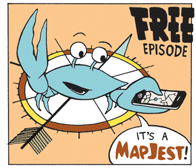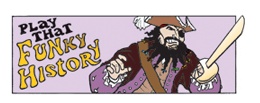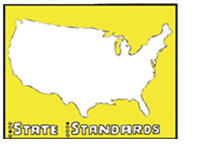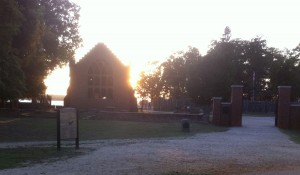












|
|

|
 |
||
 |
"(Our son) is only in second grade, but he desires a higher knowledge of things. These were perfect because they gave him better and more detailed information at a level that was easier for him." The Breteys |
|
|
|
||
Archive for the ‘Historical Travel’ Category
Battle of Antietam
Written on Monday, September 24th, 2012 [permanent link]
A week ago I woke up in a Maryland field to the sound of a rooster crowing.
And then the cannon started.
After that came the bugles that I normally hear for reveille. But the cannonfire was a nice touch. I’M AWAKE! I’M AWAKE!! My 15-year-old son and I were camping just north of the Antietam National Battlefield with 4,000 other reenactors for the 150th anniversary of the Civil War battle. The spread of hundreds of canvas tents under the pink morning sky was inspiring. In our four years of reenacting, I’ve never seen more cavalry or more artillery on the field, sweeping to and fro during the afternoon battles for the spectators.
It’s like watching a moving painting. I portray a battlefield cartoonist, so I’m not marching in the lines of blue and gray but standing back on a hill, furiously sketching what it looks like for 400 men to storm a fence held by 250 other men. And I can also zoom down to sketch details that will add depth my own visual storytelling — how does the pot over the campfire look? How does J.E.B. Stuart hold his sword as he charges? And being in the mix of reenactors gives my other senses a chance to record details for me to use later. How hot is it in the wool clothing at midday? How do your feet feel after a day of marching? What does a Civil War mortar sound like when it fires?
Being on the actual field gives me a chance to research outside the box that a movie or TV show presents. The past 20 years have been revolutionary for the increasing number of historical movies and TV shows we get that have told great stories with great accuracy. But movies and TV shows are still a frame, capturing what a director or editor wants you to see — and leaving out the rest of the story. I’ve found that there’s no substitute for being able to stand somewhere to get a sense of the place and the historical event that happened there.
The visuals are a big part of the story of Antietam — the single bloodiest day in American history. Because Robert E. Lee’s Confederate army was caught so close to Washington, DC, a few days after the battle Alexander Gardner was able to photograph the dead men still in the field. Gardner’s photos were the first ever images to show dead soldiers on the field of battle. A New York Times article about the photographs said it was if the “dead had been laid at our doorsteps.” For civilians who still thought the Civil War was a romantic crusade, those photos were an unsettling window to the brutality and waste of the war.
You can read my story about Antietam — which includes info about Gardner’s photos — by visiting the iTune store!
Tags: Antietam, Bentley Boyd, cartoonist, Chester Comix, Chester the Crab, Civil War, reenactor
Posted in Author's Purpose, Civil War, Historical Travel | Comments Off on Battle of Antietam
Give Me History or Give Me Death!
Written on Monday, June 25th, 2012 [permanent link]We get plenty of Patrick Henry thundering around the historic streets of Williamsburg, where I live. But he also made a lot of noise in Richmond during the Revolutionary Era, so yesterday I spent a lovely Sunday afternoon at Historic St. John’s Church in Richmond for the weekly reenactment of Henry’s “Give Me Liberty” speech.
It was sunny and warm — nothing like the wintery March day in 1775 when Henry and other people you know (George Washington, Thomas Jefferson, etc) gathered at the church to talk about what to do in the face of Britain’s troop surge to control Boston. St. John’s Church was the biggest, most comfortable building in what was then a village of about 600 people, and it was a good distance away from the cranky royal governor still perched in the Governor’s Palace in Williamsburg. More than 100 Virginia colonial leaders heard Henry ask that the colonists form a militia to prepare for war. When conservative leaders spoke against his motion and urged patience, Henry stood to give the rousing speech that ended with his dramatic cry.
The reenactment was rousing, too. The actors in costume sat among the people in the modern crowd and rose to speak as if we were all in that 1775 convention. At the end, we all got a vote. Back then, Henry’s resolutions passed by only five votes. But the next few weeks after that vote proved he was right — shots fired at Lexington and Concord in Massachusetts began open warfare, and a few days later Virginia’s royal governor took away the colony’s gunpowder in the middle of the night to prevent open rebellion in Virginia. It’s rare for a politician to be proven so right, so soon 😉
It was wonderful to be in the same space where Henry himself spoke. St. John’s Church was completed in 1741 — the first church built in the city of Richmond. William Byrd II, founder of the city of Richmond, donated the land and timber to build the church. The graveyard is the site of the first public cemetery in Richmond; buried there are George Wythe, signer of the Declaration of Independence and teacher of law to Thomas Jefferson, Chief Justice John Marshall, and Henry Clay; John Page and James Wood, Governors of Virginia; Elizabeth Arnold Poe, mother of Edgar Allan Poe; and Dr. James McClurg, a Virginia delegate to the Constitutional Convention of 1787.
If you’re in Richmond on a Sunday afternoon this summer, go to church!
Tags: history, Patrick Henry, Richmond, St. John's Church, Virginia
Posted in Colonial Williamsburg, Historical Travel, History Teacher | No Comments »
Bacon’s Rebellion on Jamestown Island
Written on Tuesday, September 28th, 2010 [permanent link]A week ago I found myself on Jamestown Island on a Saturday night for the annual telling of the story of Bacon’s Rebellion. Of course I’ve been out to the island many times in the 18 years that I’ve lived in the Historic Triangle, but I had never been there for this event. What a cool and calm feeling watching the sun set over the church and then watching the moon rise over the fields where some experts made it feel like 1678!
Willie Balderson was the leader of the crew that night. He is one of the best actors in the Williamsburg area, in part because he can range so widely across the timeline. For years he has led groups on this annual walk through Bacon’s Rebellion — the first major uprising of American colonists against British royal authority (a century before the Declaration of Independence). He has a deft touch in making the story understandable to modern audiences but still making them feel he was a participant in that story. (It helps that the crowd’s interest mirrors what actually happened: after the rebellion the king sent investigators to Virginia to interview people to find out what went so haywire.)
It’s a dramatic story that very few Americans know about — probably the biggest adventure that is untold to modern audiences. Well, except for my own version of it in my Founding Fathers book. 😉
Jamestown Island is great example of how I can do what I do for a living. It is a favorite among locals because it has beautiful hiking and biking just a few minutes away from our community. It is amazing that we have such historic ground so nearby, where we can see the marshes at sunset, watch a bald eagle eat dinner on the James River seawall, or hear the archaeologists tell us what they’ve learned about Jamestown Fort today that they didn’t know a month ago. It’s getting harder to find those unique pieces of ground in America, but this is easy to get to and there’s no Wal-Mart around!
Tags: Bacon's Rebellion, Bentley Boyd, Chester Comix, Jamestown Island, Virginia, Willie Balderson
Posted in Author's Purpose, Historical Travel, History Teacher | No Comments »



